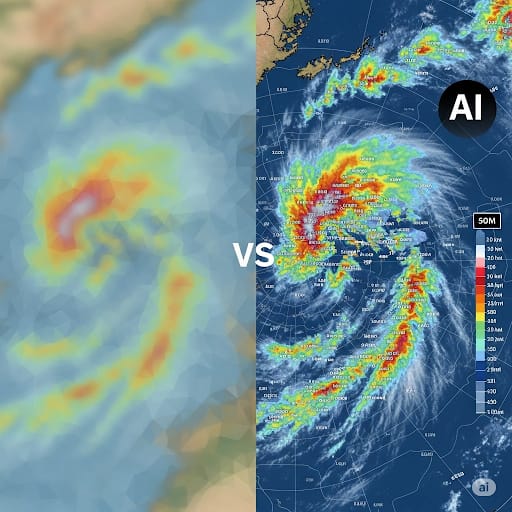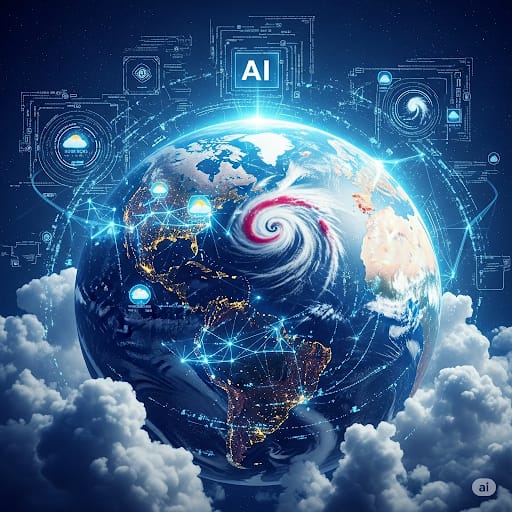AI weather control
AI Weather Control: Predicting the Unpredictable and Shaping Our Response
The increasing frequency and intensity of weather extremes—from devastating droughts and catastrophic floods to powerful hurricanes and unexpected heatwaves—pose a significant challenge to global communities. Traditional methods of weather forecasting, while crucial, often struggle with the speed and precision required for real-time prediction of these complex events. Moreover, access to sophisticated forecasting infrastructure remains a barrier for many developing nations. This is where Artificial Intelligence (AI) steps in, offering a paradigm shift in how we understand, predict, and ultimately respond to the volatile nature of our planet's weather.
Why Traditional Forecasting Falls Short in the Face of Extremes
Conventional numerical weather prediction (NWP) models rely on solving complex physical equations that describe the atmosphere and oceans. While incredibly powerful, these models demand immense computational resources and can take significant time to produce forecasts. This latency can be critical when dealing with rapidly evolving extreme weather systems. Furthermore, the accuracy of these models is often limited by the resolution of the data they ingest and inherent uncertainties in atmospheric dynamics. For many developing countries, the financial and infrastructural hurdles of deploying and maintaining the necessary supercomputing facilities and accessing high-resolution satellite data create a significant forecasting gap, leaving vulnerable populations less prepared.

Enter AI: A Global Forecasting Game-Changer with Speed and Accessibility
AI-based weather prediction models are not just incremental improvements; they represent a fundamental shift in forecasting methodology. By leveraging machine learning algorithms, these models can process vast quantities of historical and real-time weather data—including satellite imagery, radar readings, surface observations, and even climate data—in mere seconds. This allows for significantly faster prediction cycles and the potential to identify and track emerging extreme weather events with greater agility. Crucially, some AI models are designed to run efficiently on relatively basic computer hardware, even standard laptops, democratizing access to advanced forecasting capabilities for regions with limited resources.

A Closer Look at Top AI Weather Prediction Models
- Aardvark Weather (Cambridge & Microsoft): This model stands out for its ability to deliver surprisingly accurate short-term forecasts using minimal computational resources, making it a powerful tool for regions where access to supercomputers is limited. Its efficiency allows for localized and rapid updates, crucial for timely warnings.
- Atmo (Google): By training on massive datasets of high-resolution weather simulations, Atmo achieves remarkable speed and detail, outperforming traditional models in detecting the early formation and intensification of severe weather phenomena like droughts and storms. Its granular predictions can provide crucial lead time for preparedness.
- GenCast (DeepMind): DeepMind's approach utilizes ensemble forecasting techniques within an AI framework to generate mid-range forecasts (up to 15 days) with impressive accuracy. Ensemble forecasting involves running multiple simulations with slightly different initial conditions, and AI helps to intelligently combine these to produce more reliable predictions.
- GraphCast (Google): This graph neural network-based model has demonstrated the ability to generate medium-range forecasts in under a minute, often surpassing the accuracy of conventional numerical weather prediction systems. Its speed and precision offer significant advantages for various sectors.
- Pangu-Weather (Huawei): Trained on a massive global weather dataset, Pangu-Weather is a 3D high-resolution model particularly adept at predicting the track and intensity of cyclones with speed and accuracy, crucial for issuing timely alerts and facilitating evacuations.
- FourCastNet (NVIDIA): Leveraging the power of NVIDIA's hardware acceleration, FourCastNet can generate a week-long, high-resolution global weather forecast in an astonishing two seconds. This speed opens up possibilities for real-time adjustments and rapid dissemination of critical information.
- ECMWF AI Forecast System (European Centre for Medium-Range Weather Forecasts): By integrating AI techniques with their existing powerful models, ECMWF has achieved a significant boost in forecast accuracy (around 20%), providing more reliable real-time global weather predictions that benefit numerous applications.

The Multifaceted Benefits of AI in Weather Prediction and Response
- Enhanced Early Warnings for Extreme Weather Events: The speed and accuracy of AI models lead to earlier and more precise warnings for hurricanes, floods, heatwaves, and other dangerous events, allowing for more effective evacuation plans and resource mobilization, ultimately saving lives and reducing damage.
- Global Accessibility and Democratization of Forecasting: AI models that can run on less powerful hardware bridge the forecasting gap, providing critical information to vulnerable communities in developing nations who previously lacked access to reliable, timely predictions.
- Faster and More Informed Decisions Across Sectors: Accurate and rapid AI-powered forecasts enable better decision-making in critical sectors like agriculture (optimizing planting and harvesting schedules), aviation (improving flight safety and efficiency), and disaster relief (allowing for proactive deployment of aid and personnel).
- Revolutionizing Climate Modeling Accuracy: AI is not only improving short-term weather prediction but also enhancing the accuracy of long-term climate models by identifying complex patterns and relationships in vast climate datasets, leading to more reliable projections of future climate scenarios.
- Optimizing Renewable Energy Production: Accurate wind and solar power forecasts, powered by AI, can help optimize the management and integration of renewable energy sources into the power grid, leading to greater efficiency and reliability.
- Improving Water Resource Management: AI can analyze weather patterns and hydrological data to provide better predictions of rainfall and drought, aiding in more effective management of water resources for agriculture, industry, and human consumption.
Beyond Prediction: The Future of AI in Shaping Our Climate Response
While the term "weather control" remains largely in the realm of science fiction, AI's role is rapidly expanding beyond just prediction. We are beginning to see AI being used to optimize responses to weather-related disasters, such as:
- Intelligent Resource Allocation: AI algorithms can analyze real-time weather data and disaster impact assessments to optimize the allocation of emergency services, supplies, and personnel to the areas of greatest need.
- Dynamic Evacuation Planning: AI can assist in creating and adjusting evacuation plans based on the evolving path and intensity of a storm, taking into account population density and infrastructure limitations.
- Damage Assessment and Recovery Efforts: AI-powered image recognition and analysis of satellite and drone imagery can rapidly assess the extent of damage after a disaster, speeding up recovery efforts and insurance claims processing.
Ethical Considerations in AI-Driven Weather Forecasting
As we increasingly rely on AI for weather prediction, it's crucial to consider the ethical implications. Issues such as data bias in training AI models, the potential for over-reliance on AI leading to a decline in traditional meteorological skills, and equitable access to these advanced technologies across different socioeconomic groups need careful consideration and proactive solutions.
What’s Next? The Continued Evolution of AI in Weather and Climate Science
AI isn’t about controlling the weather—at least not in the way we might imagine—but it is fundamentally revolutionizing how we predict, understand, and respond to its complexities. As the threats posed by climate change intensify, AI is poised to become an even more powerful ally in our efforts to stay prepared, mitigate risks, and build more resilient communities in the face of an increasingly unpredictable environment. The ongoing research and development in this field promise even more sophisticated and impactful applications of AI in the years to come.

Explore More Scientific Wonders:
- The Future of Nuclear Fusion: Unlimited Clean Energy?
- Why Time Slows Down: The Science of Time Dilation
Follow and Connect:
Stay updated by clicking the follow button on the sidebar!
Privacy Policy | Disclaimer | About the Author
Comments
Post a Comment